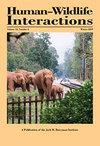遥感技术在降低巴西东南部飞机鸟击风险中的应用
IF 0.9
4区 环境科学与生态学
Q4 BIODIVERSITY CONSERVATION
引用次数: 5
摘要
飞机与鸟类碰撞的次数不断增加,需要制定适当的缓解措施,以控制机场附近鸟类的数量。黑秃鹫(Coragyps atratus;秃鹫)被认为是巴西航空最危险的物种之一。为了更好地了解秃鹫的空间分布格局及其对航空安全的威胁,我们研究了自然和人为的表面因素,并对巴西东南部阿马莱斯机场和总统普吕登特机场的机场安全区(ASA)上空与鸟类碰撞的风险进行了数值估计和绘制。为了进行我们的研究,我们在2012年9月至2013年8月期间,从20公里ASA区域内的26个点每月调查翱翔的黑秃鹫。我们从卫星图像中获得了环境参数(地形、地表温度、地表覆盖类型和人为压力),并将其与我们的秃鹫调查进行了地理参考。利用Spearman’s rank correlation和主成分分析对数据表进行检验,以确定秃鹫飞行模式与ASA环境特征之间是否存在任何关系。我们发现,表面温度的对比与秃鹫翱翔的强度密切相关。秃鹫倾向于利用周围最强的热源翱翔。地形参数包括海拔高度、坡度暴露度和倾斜度与秃鹰翱翔活动无关。水体和道路是对翱翔的秃鹫最具吸引力的景观。我们记录了在不间断的城市化土地上翱翔秃鹫的最少数量。然而,被自然和乡村景观包围的分散的城市聚居地被翱翔的鸟类选中。为了降低ASA区域的鸟击风险,我们建议管理者应该在风险评估图上绘制出产生吸引秃鹫的热量的物体,并改变航空路线以避开它们。本文章由计算机程序翻译,如有差异,请以英文原文为准。
Remote Sensing Applications for Abating Aircraft–Bird Strike Risks in Southeast Brazil
The rising number of aircraft collisions with birds requires the development of appropriate mitigation measures to control their populations in the vicinity of airports. The black vulture (Coragyps atratus; vultures) is considered one of the most dangerous species for aviation in Brazil. To better understand the spatial distribution patterns of flying vultures and the risks they may pose to aviation, we studied natural and anthropogenic superficial factors and then numerically estimated and mapped the risk of collision with birds over the Airport Safety Area (ASA) for the Amarais Airport and Presidente Prudente Airport in the southeast part of Brazil. To conduct our research, we surveyed soaring black vultures monthly between September 2012 and August 2013 from 26 points within 20-km ASA zones. We obtained the environmental parameters (i.e., relief, surface temperature, surface covering type, and anthropogenic pressure) from satellite imagery and georeferenced them with our vulture survey. The tabulated data were examined using Spearman’s rank correlation and principal component analysis to determine if any the relationships existed between vulture flight patterns and ASA environmental characteristics. We found that the contrast in surface temperatures correlated well with the intensity of vulture soaring flights. Vultures tend to soar using the strongest thermals in their surroundings. Relief parameters, including altitude above sea level, slope exposure, and inclination, were not related with the vulture soaring activity. Water bodies and roadways were the most attractive landscapes for soaring vultures. We recorded the least number of soaring vultures over the uninterrupted urbanized lands. However, the scattered enclaves of urban settlement surrounded by natural and rural landscapes were selected by soaring birds. To mitigate the bird strike risk in ASA zones, we propose that managers should plot the objects generating thermals that attract vultures on risk assessment maps and reroute aviation to avoid them.
求助全文
通过发布文献求助,成功后即可免费获取论文全文。
去求助
来源期刊

Human–Wildlife Interactions
Environmental Science-Nature and Landscape Conservation
CiteScore
2.80
自引率
0.00%
发文量
0
审稿时长
11 weeks
期刊介绍:
Human–Wildlife Interactions (HWI) serves the professional needs of the wildlife biologist and manager in the arena of human–wildlife conflicts/interactions, wildlife damage management, and contemporary wildlife management. The intent of HWI is to publish original contributions on all aspects of contemporary wildlife management and human–wildlife interactions with an emphasis on scientific research and management case studies that identify and report innovative conservation strategies, technologies, tools, and partnerships that can enhance human–wildlife interactions by mitigating human–wildlife conflicts through direct and indirect management of wildlife and increased stakeholder engagement. Our intent is to promote a dialogue among wildlife professionals concerning contemporary management issues. As such, we hope to provide a repository for wildlife management science and case studies that document and share manager experiences and lessons learned.
 求助内容:
求助内容: 应助结果提醒方式:
应助结果提醒方式:


